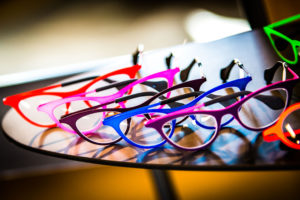At Kanata Optometry Centre you will find everything to meet your individual eyewear needs including over 1400 frames and sunglasses, and a wide variety of lenses and accessories.
At Kanata Optometry Centre our Doctors and Staff ensure your new glasses fit your visual and eye health needs, as well as your fashion sense.
We offer a wide variety of styles and brands. However, not all glasses are created equal. Some eyeglass lenses provide clearer vision; some are more scratch or impact resistant.
The corrective lens prescription given to you by your Doctor is only one piece of the information that will determine how well you see with your new eyewear. During the process of selecting and fitting your new eyeglasses, our Doctors and Staff will determine a number of things to make sure your new purchase is custom made to give you clear comfortable vision, while also ensuring you look great, including;
- Accurately measuring the distance from the bridge of your nose to the centre of each pupil, so your new lenses will be properly centred in the new frames relative to your eyes.
- Selecting the right size and shape of frame for you
- Determining what curvature of lens and type of lens material is best for you
- Determining what coatings to use on your lenses that best suit your needs
- Determining the height to place the optical centre of the lens in your frame
- Measuring how high to place the bifocal or progressive (if you wear a multifocal lens)
- Properly adjusting the frame to your face
If all of the above are not chosen specifically for you, it’s not uncommon to have problems that may be immediate or come on after using your new eyeglasses for an extended period of time. Common complaints for improperly ordered or fit eyewear can include headaches, fatigue, an “eye pulling” sensation, nausea, and pain or pressure marks on your nose or around your ears. Eyeglasses are the traditional method of correcting vision problems. They can correct almost all common vision conditions. They are available in a wide array of fashionable styles to suit many lifestyles.
Lenses Available at Kanata Optometry Centre:
Regular Plastic and High Index Plastic Lenses
- Lightweight and impact resistant

- Can be tinted for sunglasses or cosmetic tints
- Scratch-resistant coatings make the lenses more durable
- Available in photochromic tint
Glass Lenses
- More durable and scratch resistant compared to plastic
- Lens material is twice as heavy as plastic
- Can be made impact resistant but not as safe as plastic
- Should not be used in children’s eyeglasses
- Available in photochromic tint
Multifocal Lenses – Bifocals & Progressives
- Available in traditional bifocal or invisible/progressive lenses
- Traditional bifocal offers a wide reading area without distortion
- Newer progressive lenses offer a gradual change or progression of power from distance to near vision
- Latest technology in high definition digital progressive lenses is available
- Available in all lens materials
Specialty Lenses
- Newer lens designs for computer use are available (occupational lenses)
- Vocational or multi-focal lenses for working overhead
- Polycarbonate safety lenses are recommended for safety eyeglasses
- Several tints, coatings, and ultraviolet absorbing lens materials are available
Talk to your optometrist and allow them to help you make the right choices for you.
Bifocals and Progressive lenses
For anyone over the age of forty, you can likely recall the frustration of having to hold your reading material further from your face in order to read the print clearly. For those of you who are near-sighted, you likely have had to remove your spectacles in order to read a newspaper or label. Perhaps after reading for only a few minutes, fine print became blurry or eyestrain and headaches became unbearable. All of these symptoms are due to a phenomenon called presbyopia.
Presbyopia typically begins between the ages of forty and forty-five. It becomes progressively worse until the approximate age of sixty. It is a natural aging process and it is not reversible. The exact mechanism as to how it occurs is not completely understood. Generally, the focusing capabilities of the eye dissipate over time. As of now, reading spectacles and bifocal glasses or contact lenses are the only forms of treatment.
Reading glasses are the first option I will discuss. Since they are focused for reading only, they need to be removed when looking at a distance. For some people, having to put their glasses on and off repeatedly can become a nuisance. Reading spectacles are easy to adapt to and relatively inexpensive.
The second option is bifocals and there are two types. The first type of bifocal is the traditional lined bifocal. They allow distance vision through the top of the lens and up-close viewing through the lower or bifocal portion of the lens. Lined bifocals are relatively easy to adapt to and are the lower priced bifocal type. Some people find intermediate distances such as the car dashboard or computer monitor difficult to focus on with the standard lined bifocal. This visual problem can be solved by lined trifocals which incorporate two bifocal lines on the lenses.
Most people do not like the visible bifocal line on the lenses for cosmetic reasons. Therefore, the second type of bifocal available is the progressive or “no line” bifocal. This type does not have a visible bifocal line on the lens which is much more appealing. They correct for far away, intermediate and up-close distances. Progressive bifocals can take longer for the patient to adapt to and are more expensive than lined bifocals.
Some people have trouble adapting to progressive bifocal lenses due to the distortion areas on the outer edges of the lenses. This produces a “swim-effect” for some people causing an unsettled feeling. Recently there have been technical advancements in the design of progressive lenses. Digitally manufactured progressive lenses are now available. These lenses have smaller distortion areas and more precise prescription control than traditional progressive lenses. The shape and size of the frame is taken into account when the lenses are fabricated.
There are also options available for contact lens wearers who are over the age of forty and are having trouble reading. One option is monovision contact lenses. This involves wearing a distance contact lens on one eye and a reading contact lens on the other eye. They are relatively inexpensive however depth perception may be hindered. A second option available is bifocal contact lenses. There is a highly variable success rate with these types of lenses.
Much like death and taxes, presbyopia is unavoidable. As it stands now, there is no proven method to prevent, reverse, or surgically correct the process of presbyopia. Consult your local optometrist or optician to determine which type of presbyopic correction fits your particular lifestyle.



